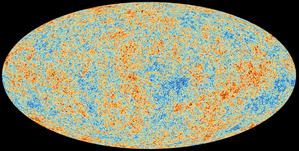Glossary term: 宇宙微波背景辐射(CMB)
Description: 宇宙微波背景(CMB)是宇宙大约 38 万年前,光与重子解耦自由传播遗留至今的电磁辐射。它提供了有关宇宙的组成、几何(形状)、演变和结构演化的信息。早期的致密宇宙是由自由粒子(质子、中子、电子)和光(光子)组成的 "热汤"。在CMB产生之前,光子与自由电子的相互作用阻碍了光的远距离传播。宇宙的膨胀和冷却使自由电子与质子结合形成氢原子,并使光得以在宇宙中传播。宇宙膨胀随后拉长了这些光子的波长,使它们如今可以在电磁波谱的微波区域被探测到。
Related Terms:
See this term in other languages
Term and definition status: The original definition of this term in English have been approved by a research astronomer and a teacher The translation of this term and its definition is still awaiting approval
The OAE Multilingual Glossary is a project of the IAU Office of Astronomy for Education (OAE) in collaboration with the IAU Office of Astronomy Outreach (OAO). The terms and definitions were chosen, written and reviewed by a collective effort from the OAE, the OAE Centers and Nodes, the OAE National Astronomy Education Coordinators (NAECs) and other volunteers. You can find a full list of credits here. All glossary terms and their definitions are released under a Creative Commons CC BY-4.0 license and should be credited to "IAU OAE".
If you notice a factual or translation error in this glossary term or definition then please get in touch.
Related Media
宇宙微波背景辐射
Credit: 欧空局/普朗克合作组织 credit link
License: CC-BY-SA-4.0 Creative Commons 署名-相同方式共享 4.0 国际 (CC BY-SA 4.0) icons









